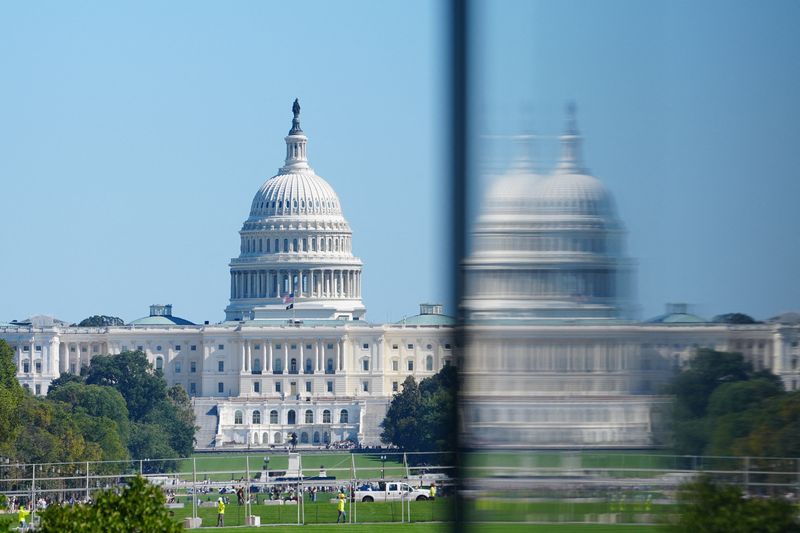By David Morgan, Andy Sullivan, Steve Holland and Nolan D. McCaskill
WASHINGTON (Reuters) -The White House on Monday backed off President Donald Trump’s assertion that government employees were already being laid off due to the shutdown, but warned job losses could result as the standoff looked set to stretch into a seventh day.
The Republican-led Senate for a fifth time rejected dueling measures to fund federal agencies, with insufficient support for both a Republican proposal to fund operations through November 21 and a Democratic version that would also extend healthcare subsidies due to expire at the end of the year.
Trump told reporters at the White House that he would be open to a deal on the subsidies, which help 24 million people buy health insurance through the Affordable Care Act – a law that Republicans bitterly opposed for years. Shoring up the expiring subsidies has been Democrats’ main demand and primary reason for voting against the Republican plan.
But on the sixth day of the shutdown, the Republican president and top Senate Democrat Chuck Schumer could not even agree whether the two sides were talking, with Trump saying there were negotiations ongoing and Schumer saying there weren’t.
The Republican-led House of Representatives was not in session, and House Speaker Mike Johnson said he had no plans to reopen it until the government was funded.
The standoff has frozen about $1.7 trillion in funds for agency operations, which amounts to roughly one-quarter of annual federal spending. Much of the remainder goes to health and retirement programs and interest payments on the growing $37.88 trillion debt.
BACKTRACKING ON LAYOFFS
During the shutdown’s first week, the Trump administration has cut off some federal funds to Democratic-led cities and states and continued to raise the specter of mass firings, though none appeared to be forthcoming. Previous shutdowns have not forced the government to fire any workers, though hundreds of thousands are typically told not to work.
Trump said on Sunday night that layoffs were taking place “right now,” but White House Press Secretary Karoline Leavitt said on Monday he had been referring to those furloughed since Congress allowed funding to expire on October 1.
The White House budget office “is continuing to work with agencies on who, unfortunately, is going to have to be laid off if this shutdown continues,” she said at a news briefing.
Labor unions representing federal workers have sued to prevent that from happening, arguing that such layoffs would violate a law that includes criminal penalties.
The administration has already frozen at least $28 billion in infrastructure funds for New York, California and Illinois — all home to sizable Democratic populations and critics of the president.
But Democratic leaders showed no sign of knuckling under to the White House’s hardball tactics, which have caused unease among some centrist Republicans who fear the approach could make the impasse harder to overcome.
The partial shutdown, the 15th since 1981, was on track to stand alone as the fourth-longest in U.S. history on Tuesday, exceeding the six-day length of a 1995 shutdown. The longest shutdown lasted 35 days in 2018-2019, during Trump’s first term in office.
While border guards, airport security screeners and other “essential” employees remained on the job without pay, other government activities ground to a halt. The Federal Register, which typically lists more than 100 proposed regulations and other notices daily, only showed four entries on Monday morning.
Pressure to end the standoff could mount next week, when 1.3 million troops and other military workers are due to miss their paychecks for the first time since the shutdown began.
Air travel could be another factor. More of the nation’s 13,000 air traffic controllers have been calling in sick since the shutdown began, which could lead to flight delays, Transportation Secretary Sean Duffy said. Lawmakers resolved the last shutdown in 2019 after absences of controllers and airport security screeners spiked.
Republicans hold a 53-47 Senate majority but need the votes of at least eight Democrats to meet the chamber’s 60-vote threshold for most legislation, since Republican Senator Rand Paul opposes the stopgap funding measure. So far only two Democrats and an independent who caucuses with them have crossed the aisle.
Some Democrats want a deal on healthcare subsidies in place before open enrollment for next year begins on November 1.
Johnson said a solution could not be reached quickly.
“We’ve got probably 100 ideas for reforms on the table, but I can’t snap my fingers this afternoon and make that happen,” he said on the Hugh Hewitt radio show.
(Reporting by Doina Chiacu, Andy Sullivan, Jeff Mason, David Morgan and Nolan D. McCaskill; Editing by Scott Malone and Cynthia Osterman)

